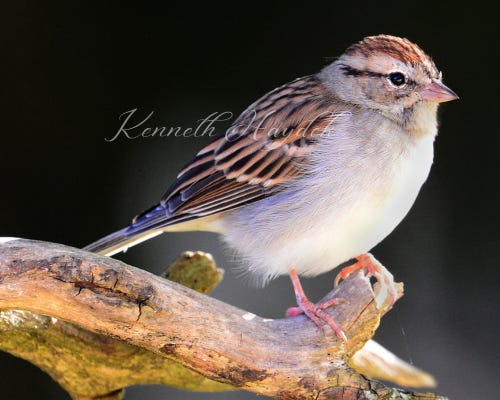October: The Chipping Sparrow
Chipping sparrows are common backyard visitors through almost all North America. Some are year-round permanent residents in Central America, Mexico, and southern United States, while others live there only in the winter months. As short-distance migrants, their breeding range covers nearly the entire contiguous United States and south-central Canadian provinces, all the way to central Alaska. During spring and fall migrations, they are commonly mixed in with flocks of other sparrows.
Chipping sparrows are likely called “chipping” because of their crisp, chipper, high-pitched song; their “chippy chippy chippy” single-note trill is one that’s often heard in backyards, grassy roadsides, and local parks.
In breeding season, chipping sparrows have bright chestnut crowns, gray-white faces and underparts, and brown, black, and white barred bodies. During non-breeding seasons, they molt into more bland, buffy bodies with dull rusty caps and gray rumps. However, a dark eye stripe can be seen during all seasons, extending from the back of their heads to their medium-sized bills. In other sparrow species, this dark eyeline stops at the eyes and does not go all the way to the bills. So, if their chipping song doesn’t give them away, be on the lookout for this distinctive eyeline feature to help identify them.
Chipping sparrows tend to nest three to ten feet above ground and seem to prefer evergreen trees for their nests, but will also select deciduous trees like crabapples or maples or even more unusual spots like hanging baskets on a pleasant porch.
While males guard females during nest construction, nest-building is solely the work of the female. Females seem to be picky about nest placement and may abandon a partially-built nest in favor of a seemingly better location. Nests of chipping sparrows are often described as “flimsy”—a loose arrangement of plant fibers and animal hairs. In fact, their use of animal hair once earned them the nickname “hair bird,” for regularly lining their nests with horse hair at a time when horses were prevalent modes for transportation.
Chipping sparrows are prolific. Males may mate with more than one female; chipping sparrows may have as many as three broods in a season, with two to seven eggs each time. One of the biggest threats to the success of a chipping sparrow brood is the brown-headed cowbird who often parasitize their nests.
When you see chipping sparrows, chances are you will spot them foraging through grass. In spring and summer, they bulk up on insects, mostly picked from the ground, though sometimes caught mid-air. In the fall and winter, seeds from grasses of all kinds become their typical fare.
If you’re looking to welcome some of these birds in your backyard during their fall migration, cracked corn and black oil sunflower seeds often attract chipping sparrows to open trays and feeding platforms. Areas with seeding native or ornamental grasses are also likely to be a draw for them. Regardless of the season, these chipper little visitors are sure to bring to one’s face a smile or two.
Sources:
https://www.allaboutbirds.org/guide/Chipping_Sparrow/overview
https://www.audubon.org/field-guide/bird/chipping-sparrow
https://ebird.org/species/chispa
https://abcbirds.org/bird/chipping-sparrow/
https://www.birdsandblooms.com/birding/bird-species/sparrows/identifying-chipping-sparrows/



